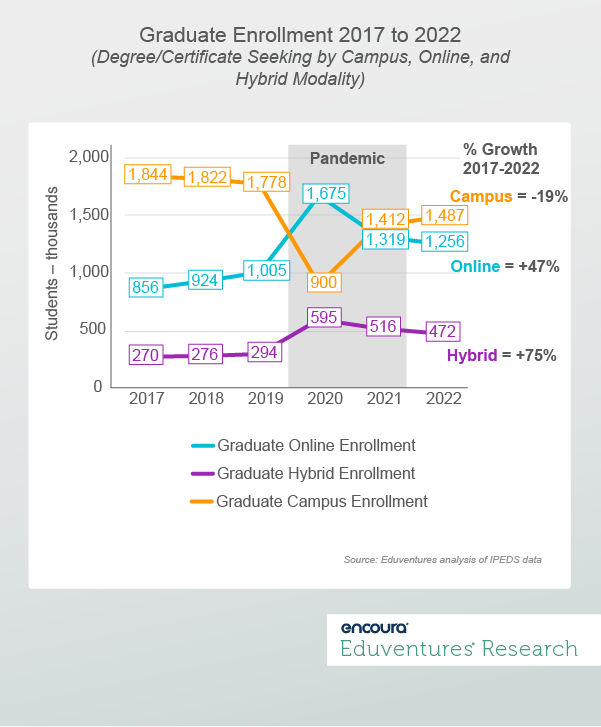More programs continue to move online, especially at the graduate level. According to IPEDS, more than 6,800 new online graduate programs were added between 2019 and 2022, and online graduate enrollment grew by 250,000.
This continuing growth is good news for online programming, but it also poses a challenge for institutions looking to enter or expand their online footprints. The more online programs there are, the harder it is to stand out.
To help institutions gain valuable competitive intelligence, Eduventures is turning to a new data source—one that can help institutions benchmark online programs and reveal how to differentiate in mature markets.
A Crowded Online Market
The pandemic prompted more institutions to make online learning a priority—to increase access, broaden reach, and, of course, grow enrollment.
According to our CHLOE 8 Report, chief online officers (COOs) estimated that interest in online program options has not yet peaked. In fact, 50% of COOs reported either moderate growth (4% to 9%) or strong growth (more than or equal to 10%) in graduate online enrollment between 2021 and 2022.
Figure 1 shows that graduate online enrollment (exclusively distance) grew by 47% between fall 2017 and fall 2022, and hybrid graduate enrollment (some distance) grew by 75%. On the other hand, campus graduate enrollment declined by 19%.
Figure 1.
During the reporting years of 2020 and 2021, there was considerable ‘noise’ in enrollment numbers as many institutions grappled with the pandemic disruption and return-to-campus in fall 2021. Therefore, fall 2022, in our estimation, resembles ‘back to normal’ reporting. Because of this, it is best to compare 2019 and prior years to 2022.
Online (exclusively distance) graduate student enrollment increased by more than 250,000 in fall 2022 compared to 2019, while campus-based student enrollment dropped by more than 290,000. This trend toward online programs has reinforced the idea that online graduate programming could be a crucial source of income, prompting many institutions to assess both new and existing programs that could be offered online. But launching an online program can be risky.
How to Compete in a Crowded Market
Of the more than 6,800 new online graduate programs launched between 2019 and 2022, 51% were online master’s degrees. This rapid online program growth has exacerbated the pre-pandemic challenge of rising costs related to marketing and recruiting online students. This makes it imperative for institutions to understand their competitors and truly see which programs students are choosing.
While online programs fundamentally have national reach, there is evidence that most students enroll with an institution located within 50 miles of where they live. Therefore, institutions need to understand national online market trends, but should tailor programs to stand out in the regional market. But it can be overwhelming to identify, catalog, and analyze online program competitors.
Enter the Online Degree Database® which has compiled 30+ distinct online program characteristics for over 6,500 distinct online programs. What does this database allow us to understand?
Let’s take a look at the Master of Business Administration, the single largest master’s program and a stalwart online program. Looking at the national landscape, here are some key program data and characteristics for the online MBA market.
- There are 565 institutions that offer online MBA programs nationally.
- Forty-four of the top 100 nationally ranked institutions in the U.S. News & World Report ranking offer online MBAs.
- AACSB is the most common accreditation among all online MBA programs.
- Programs range from only 30 total credits up to 72.
- The national average total program tuition cost (not including fees) is $30,627.
- Health Care Administration/Management is the most commonly offered concentration.
By using these program features, institutions assessing their online programs can see how they compare to other online market options and be more prepared to change and improve their program offerings and positioning.
The Bottom Line
Institutions face mounting pressure to increase enrollment and online programs are widely regarded as a viable option. The online competitive landscape has become increasingly crowded, making it harder and harder to successfully launch new programs. This may continue for a while.
Eduventures can provide valuable insight into how best to position online programs and attract more of the right prospective students. Below are some scenarios that the Online Degree Database allows insight into.
- We think our online programs might be too expensive. Where does my institution stand on total program cost?
- We want to add a new concentration to our online master’s degree. Which concentrations are most offered already?
- Applicants are balking at taking an entrance exam (GRE, GMAT, etc.). Which of our competitors require an admissions test and do some have waivers?
- Our new online program wants to include an on-campus requirement. Are there competitor programs that require just a single campus intensive/immersion?
The answers to these questions depend on the specific online program and region of the institution.


